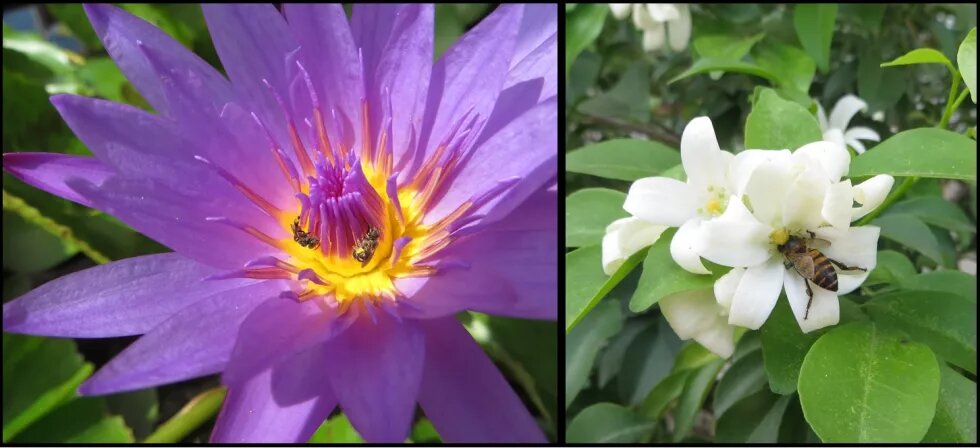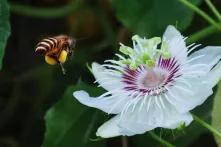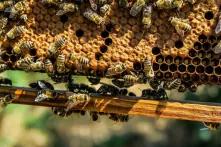
Most plants rely on animal pollinators for reproduction, especially in the tropics where an estimated 94% of flowering plant species require pollinators. However, pollinator populations have been declining worldwide, and two of the main factors driving pollinator declines include habitat loss and pesticide use. The good news is that anyone and everyone can help these important animals simply by making their yard landscaping more pollinator-friendly.

Why pollinators need our protection
Most plants rely on animal pollinators for reproduction, especially in the tropics where an estimated 94% of flowering plant species require pollinators (1). Moreover, many of our crops depend on pollinators; the yearly economic value towards global agriculture provided by insect pollinators alone is estimated to amount to €153 billion (2). However, pollinator populations have been declining worldwide, and two of the main factors driving pollinator declines include habitat loss and pesticide use (3). Bees are among the hardest hit, but other pollinators including birds and bats have also suffered from these environmental changes. The good news is that anyone and everyone can help these important animals simply by making their yard landscaping more pollinator-friendly.
What is pollinator-friendly landscaping?
This concept encompasses a variety of landscaping practices that are aimed at promoting pollinator foraging and nesting in man-made or cultivated areas with vegetation. Common practices include planting flowers that are attractive to pollinators, minimizing pesticide use, and promoting native plant diversity through reduced mowing, weeding, and herbicide application. Moreover, pollinator-friendly landscaping can be done anywhere, from an urban apartment balcony, to a small suburban lawn, to a large rural farm.
The pollinator-friendly landscaping movement has been growing in areas such as Europe and North America. For example, one city in the Netherlands converted 316 bus stops into colorful pollinator-foraging sites by planting native flowers on top of bus stop roofs (4). In the US, homeowners in Minnesota can receive financial support to plant native flowering plant species in their yards, an incentive initiated by the state to help conserve an endangered bumblebee as well as other important pollinators (5). Additionally, pollinator gardens are becoming more popular in primary schools as a means of teaching young students about the importance of pollinators, as well as providing them with hands-on experience and close interaction with pollinators (6).
Benefits of pollinator-friendly landscaping
In addition to the main benefit of helping protect pollinators, many homeowners soon realize the many other benefits of practicing pollinator-friendly landscaping. For example, the time and money saved, compared to conventional lawn care. Pollinator-friendly lawns typically require less maintenance: less time spent mowing, watering, and applying fertilizers, pesticides, and herbicides. Homeowners also spend less money on purchasing chemical lawn-care products, or on hiring landscapers to tend to their lawns. Another major benefit is the aesthetic value that pollinator-friendly landscaping brings to lawns. While conventional lawns typically consist of large swaths of homogenous grass, pollinator-friendly landscapes incorporate a variety of plant species that often have vibrant flowers. Finally, pollinator-friendly landscapes have a much more positive environmental impact than conventional lawns, not just in terms of pollinators, but also for the many other species of wildlife that coexist with us, and for the health of the planet that we live on.
Pollinators in Southeast Asia
Southeast Asia has very high biodiversity, which also extends to its pollinators. The abundance of flowers found year-round and mild climate provide an ideal environment for pollinators of all shapes and sizes. While some people may only think of bee pollinators, there are actually a variety of animal species that pollinate flowers, and it is possible for pollinator-friendly landscaping to benefit all of them! Below are some of the most common pollinator species found in Southeast Asia.
Bees: Perhaps the most well-known pollinator is the honey bee, but there are actually several species of honey bee. The most common honey bee species found in SE Asia are the Asian giant honey bee (Apis dorsata), eastern honey bee (Apis cerana), and the red dwarf bee (Apis florea). These three species can be found in all types of habitats, from wild to agricultural to urban, and pollinate a wide variety of flowers. Another group of bees that are extremely common in SE Asia are the stingless bees (Meliponini), of which there are over 500 species worldwide! Stingless bees are much smaller than honey bees, and many people do not even realize that they are bees. As their name suggests, they cannot sting for defense as most other bees can, which makes them an attractive option for bee-keeping. Other common bees found in SE Asia include the carpenter bees (Xylocopa and Ceratina genera), sweat bees (Lasioglossum and Nomia genera), blue-banded bees (genus Amegilla), and leaf-cutter bees (genus Megachile), all of which help pollinate flowers as well.
Butterflies: Butterflies feed primarily on nectar, which also makes them excellent pollinators. Their vivid colors also make them a pretty addition to any yard or garden! There are over 1,200 species of butterfly found in SE Asia, but some of the most common species include the Jay butterflies (genus Graphium), Lime Butterfly (Papilio demoleus), Great Mormon (Papilio memnon), Emigrant butterflies (genus Catopsilia), Painted Jezebel (Delias hyparete), Tiger butterflies (genus Danaus), Crow butterflies (genus Euploea), Eggfly butterflies (genus Hypolimnas), Pansy butterflies (genus Junonia), and Palmfly butterflies (genus Elymnias). The websites <butterflycircle.com> and <butterflycircle.blogspot.com> are excellent resources for identifying butterflies.
Other insects: After establishing your pollinator-friendly yard, you may notice other insects visiting your flowers, too. Some of the more common groups include the “flower flies” or “hover flies” (family Syrphidae), and diverse wasp and beetle species. If you observe your flowers in the evening, you may also notice some moths, such as the “hawk moths” or “sphingid moths” (family Sphingidae).
Birds: Most bird species are not pollinators, but some groups do feed on nectar and help pollinate flowers. The most common nectarivorous groups are the sunbirds and spiderhunters (family Nectariniidae) and the flowerpeckers (family Dicaeidae). The olive-backed sunbird (Cinnyris jugularis) and brown-throated sunbird (Anthreptes malacensis) are common in many habitat types, while spiderhunters (genus Arachnothera) are more common in forested habitats.
Bats: Most bat species are also not pollinators, as most are insectivorous, but the Pteropodidae family consists entirely of nectar- and/or fruit-eating species. There are three common bat species in SE Asia that forage exclusively on nectar: the cave nectar bat (Eonycteris spelaea), the long-tongued fruit bat (Macroglossus sobrinus) and the lesser long-tongued fruit bat (M. minimus). There are also a number of common bat species that forage on both fruit and nectar, including the flying foxes (genus Pteropus) and fruit bats in the genus Cynopterus.
How to create a pollinator-friendly yard
1. Select “no-mow” or “reduced-mow” areas. The corners and edges of your yard are often good areas, because people usually don’t walk or play there, and they are often more difficult to mow anyways. Let these areas grow unhindered, or perhaps use a reduced mowing schedule (e.g., only mow during periods when your lawn doesn’t have many flowers), and see the diversity of species that establish on their own. Or you can take a more active role in facilitating wildlife diversity by planting or seeding native plant species of your choice (see “pollinator-friendly plant species” below for suggestions). It is particularly beneficial if you can choose diverse plants that flower during different times of the year, so that pollinators have a year-round supply of flowers to forage from. Once a variety of plant species have become established in your yard, the pollinators (and other types of wildlife!) will quickly follow! No-mow areas are particularly beneficial to ground-nesting bee species, where they can build their nests undisturbed.
2. Select ground cover plants. In high traffic areas, where people often walk or kids often play, consider replacing ornamental turf (which are often non-native species that require moderate-to-high maintenance) with low-growing, hardy native plant species. These “weedy” species require less watering and fertilizer than ornamental grasses, and also have the additional benefit of providing flowers that pollinators can forage on. Moreover, by planting low-growing species, you won’t have to mow often, or possibly at all.
3. Minimize pesticide use. Chemical pesticides are harmful to pollinators, so the less you use the better. Yet by following the first two steps above, you will likely find that your plants have fewer pests in general. Areas of high plant diversity (such as “no-mow” areas described in step 1) typically experience fewer pests than monocultures or areas with low plant diversity because the mosaic of plants makes it more difficult for pests to spread from one host plant to the next. Additionally, selecting native, hardy species as your main ground cover (such as is described in step 2) can help minimize pesticide use because these “weedy” species often have adaptations that make them unpalatable to pests. However, if you do encounter pests and prefer to take action against them, consider using natural remedies or organic pesticides, such as neem oil, diatomaceous earth, or chili peppers. It can also be less harmful to pollinators if pesticides are applied when pollinators aren’t around, such as when plants aren’t flowering.
Pollinator-friendly plant species
Lastly, here are some suggestions for plant species preferred by different groups of pollinators. Most flowers are effective at attracting at least some pollinator species, although beware of plant species whose flowers have been highly modified via human selection and cultivation, as these species may no longer produce pollen or nectar and therefore are not attractive to pollinators. The list below specifically focuses on plant species that are native to SE Asia, because while some pollinators don’t mind foraging on exotic species, others are known to prefer native flowers. Moreover, native plant species are already adapted to the climate so they require less maintenance. Lawns and gardens often contain a large proportion of exotic species, but by consciously choosing native plant species, we can help both native pollinators and native flora!
Bees: Most bee species have broad diets and are happy feeding from a variety of flowers. Some plant species that are native to SE Asia and that are especially attractive to bees include: yellow flametree (Peltophorum pterocarpum), water lilies (genus Nymphaea), Indian hemp (Crotalaria juncea), mango (Mangifera indica), fragrant randia (Oxyceros horridus), bluewings (Torenia fournieri), greater galangal (Alpinia galanga), parrot’s beak (Gmelina philippensis), basil (Ocimum basilicum), orchid tree (Phanera purpurea), snowy orchid-tree (Bauhinia acuminata), crape myrtle (Lagerstroemia indica), queen crape myrtle (Lagerstroemia speciosa), and Thai crape myrtle (Lagerstroemia floribunda).
Butterflies: Butterflies tend to have more specialized diets than bees, and forage on fewer flowering plant species. Native plant species known to attract butterflies include: false daisy (Eclipta prostrata), Indian heliotrope (Heliotropium indicum), fragrant randia (Oxyceros horridus), asoka-tree (Saraca indica), jasmine orange (Murraya paniculata), water jasmine (Wrightia religiosa), coleus (Plectranthus scutellarioides), plumed cockscomb (Celosia argentea), golden shower (Cassia fistula), and crepe ginger (Cheilocostus speciosus).
Birds: Birds also tend to have more specialized diets than bees, particularly since they require flowers or stems that are sturdy enough for them to perch on. Native plant species known to attract nectarivorous birds include: orchid tree (Phanera purpurea), banana (genus Musa), and several species of ginger (Costus spicatus, Hornstedtia tomentosa, and Etlingera brevilabris).
Bats: Bats forage at night, and therefore require flowers that bloom nocturnally. Native plant species known to attract nectarivorous bats include: durian (Durio zibethinus), banana (genus Musa), bitter bean (Parkia speciosa), kapok (Ceiba pentandra), Indian trumpet flower (Oroxylum indicum), and mangrove trees in the genus Sonneratia.
This list is by no means comprehensive. Feel free to experiment with different plant species of your own choosing, and see which are most attractive to the pollinators in your area!
References
- Ollerton, J., Winfree, R., & Tarrant, S. (2011). How many flowering plants are pollinated by animals?. Oikos, 120(3), 321-326.
- Gallai, N., Salles, J. M., Settele, J., & Vaissière, B. E. (2009). Economic valuation of the vulnerability of world agriculture confronted with pollinator decline. Ecological economics, 68(3), 810-821.
- Potts, S. G., Biesmeijer, J. C., Kremen, C., Neumann, P., Schweiger, O., & Kunin, W. E. (2010). Global pollinator declines: trends, impacts and drivers. Trends in ecology & evolution, 25(6), 345-353.
- Hirsh, S. (2019). Bees can take refuge on these bus stop “green roofs”. https://www.greenmatters.com/p/bus-stops-for-bees
- Gotlieb, N. (2020). State offers funds for pollinator-friendly plants. https://www.southwestjournal.com/voices/green-digest/2020/02/state-offers-funds-for-pollinator-friendly-plants/
- Meredith, D. (2020). Youth pollinator gardens can help sustain food supply. https://www.tallahassee.com/story/life/home-garden/2020/03/23/youth-pollinator-gardens-help-sustain-food-supply/2869625001/




